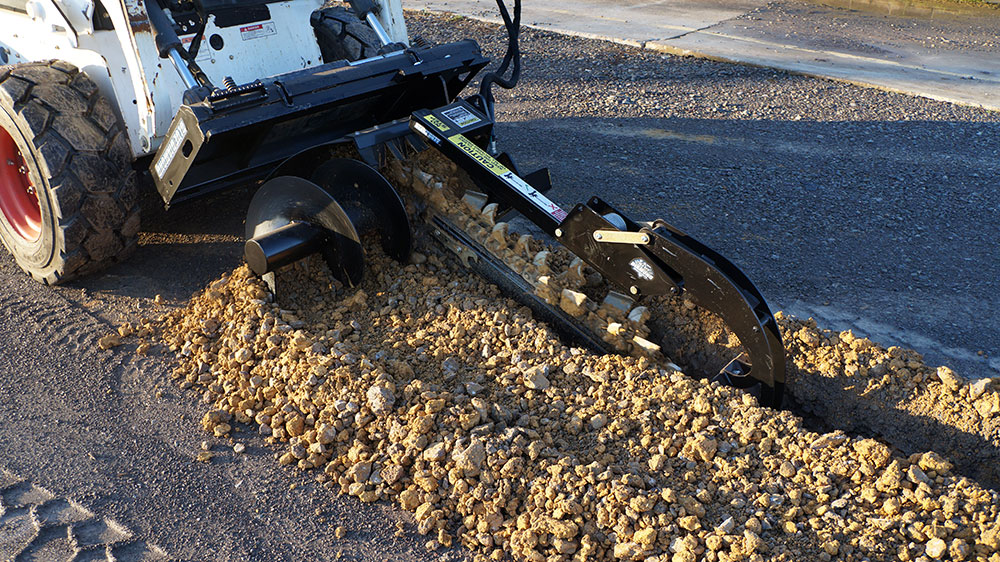How to Use a Trencher?

Table of Contents:
1. Types of Trenchers
2. How Are Trenchers Built?
3. How to Use a Trencher?
4. Trencher Applications
5. How to Get a High-Quality Trencher Attachment?
Do you know what is one of the most useful pieces of equipment a contractor can operate? A tool that can cut through hard or rocky soil with astonishing precision. Let us introduce you to a trencher. What are its types, when and how to use it? Read on to discover all the details.
Types of Trenchers
You can either buy a trencher or turn your skid steer into one using a trencher attachment. If you decide to buy a trencher, you can choose between two types.
Walk-Behind Trencher
Walk-behind trenchers are used for small or medium-sized applications. They work well in soft terrain and are perfect for irrigation, French drains, or other commercial construction projects. They are also very precise, especially if you choose a small trencher. It will allow for smooth and easy trenching for cables or plumbing.
Operating a walk-behind trencher is slightly more demanding than operating a ride-on trencher. The trencher is pulled behind which is why it is usually less powerful. On the plus side, it has a greater maneuverability, therefore straight trenches in narrow places are done in no time.
Ride-On Trencher
Do you need a powerful machine for a large project involving digging trenches? A ride-on trencher will be a perfect choice. Thanks to its greater horsepower, it can operate in harder terrain and across long distances. Ride-on trenchers are not very precise but can dig long and deep trenches in all terrain conditions.
How Are Trenchers Built?
Both types of trenchers can either be wheel trenchers or chain trenchers. Rock wheel trencher is the best option for hard soils, rocks, and pavements. It has a toothed metal wheel to break a firm surface and special parts (spacers and ejectors) to deal with debris while in operation. A chain trencher has a digging belt, which looks like a chainsaw. It delves into the soil with ease, allowing the operator to manage the depth of the trench.
How to Use a Trencher?
In this article, we focus on using a skid steer trencher attachment. Therefore, all the steps below apply to you if you own a skid steer loader.
Inspect and Examine the Trencher and the Area
The most crucial part when it comes to the operation of any equipment is to ensure the machine's proper functioning and the operator's safety. Read your machine's manual and check if none of the parts are broken or leaking. If you suspect any hazard, refrain from using the machine and contact the repair team.
It is crucial to ensure that none of the underground infrastructure of the area (water or electrical lines) is affected by the trenchers' operation. Also, it is a good idea to familiarize yourself with local regulations.
Mount Your Attachment
Attaching the trencher's part to your skid steer is not difficult but ensuring that all pins are locked in their place is a crucial step before you start the operation. A crucial step is also hooking up the hydraulic lines. These will be with male and female flat face couplers.
Start Operation
Once all parts are attached to the skid steer, it is time to start trenching. Start by pointing the chain in the desired direction and elevating it around two feet above the ground. The trencher chain should never be on the ground when you start trenching. It will put too much resistance on your tool.
Once the engine is running, tilt the trencher arms down at a 45-degree angle for an initial cut. Now, you can safely lower the tool into the ground to the desired depth.
Reverse
Once you have reached the desired depth, move in reverse to form the trench. If your skid steer has a 'creep' mode, turn it on. It will allow for smooth, slow work and a maximum supply of hydraulic flow to the attachment. Keep the auger at ground level. It will keep the material from falling into the trench.
Finish and Disconnect
Once you finish trenching, lift the trencher, switch off the engine, and disconnect the attachment. Clean and inspect it thoroughly.
Trencher Applications
Besides the obvious trencher applications, there are others that you may have not known about. Let us go through some of the other jobs your trencher attachment can perform.
Removing Tree Roots
Cutting roots is only possible if you have a trencher blade with carbide teeth. Otherwise, you might damage the equipment. Remember that if you are dealing with larger rooting systems and stumps, it is better to use one of the forestry attachments.
Landscaping
To save yourself a hassle and unnecessary physical labor, get a compact trencher and deal with all your gardening and landscaping quickly and effortlessly.
Hiding Cables
Many power companies use trenchers to dig narrow trenches and ensure the safety of their electrical wires.
How to Get a High-Quality Trencher Attachment?
To get your trenches done in no time, make sure you purchase a solid, good-quality attachment from a trusted supplier. Visit the skid steer trenchers and mini skid steer trenchers section of our online shop and choose from several models with hydraulic motors and different chain sizes and designs based on your application. Do not hesitate to get in touch if you need assistance choosing a part of the appropriate specifications.

